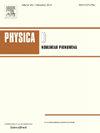流动的植物-草食动物浪潮可以维持受到干旱和人口增长威胁的生态系统
IF 2.9
3区 数学
Q1 MATHEMATICS, APPLIED
引用次数: 0
摘要
旱地植被可以通过形成空间格局来克服缺水压力,但往往受到草食的额外压力,使其面临荒漠化的风险。了解植被格局和草食之间的相互关系对于确保旱地的粮食生产至关重要,旱地占全世界牧场的大部分。在这里,我们介绍了一个新的植被-草食动物模型,该模型捕获了与水和草食胁迫相关的模式形成反馈,以及草食动物代表开发策略的行为方面。研究发现,草食胁迫可诱发草食-草食流动波,并揭示了其形成的生态机制。行波状态下,草食动物分布不对称,各植被斑块一侧密度较高。在低降水量时,草食动物的分布是局部的,而在高降水量时,草食动物分布在整个景观上。重要的是,它们的不对称分布造成了不均匀的草食胁迫,每个植被斑块的一侧强,另一侧弱,比空间均匀的草食动物分布所施加的应力要弱。因此,行波的形成增加了对草食胁迫的可持续性。综上所述,植物-草食行波可能在水-草食复合胁迫条件下维持草食种群数量,从而为受干旱和人口增长威胁的濒危地区的粮食安全做出贡献。本文章由计算机程序翻译,如有差异,请以英文原文为准。
Traveling vegetation–herbivore waves may sustain ecosystems threatened by droughts and population growth
Dryland vegetation can survive water stress by forming spatial patterns but is often subjected to herbivory as an additional stress that puts it at risk of desertification. Understanding the mutual relationships between vegetation patterning and herbivory is crucial for securing food production in drylands, which constitute the majority of rangelands worldwide. Here, we introduce a novel vegetation–herbivore model that captures pattern-forming feedbacks associated with water and herbivory stress and a behavioral aspect of herbivores representing an exploitation strategy. We find that herbivory stress can induce traveling vegetation–herbivore waves and uncover the ecological mechanism that drives their formation. In the traveling-wave state, the herbivore distribution is asymmetric with higher density on one side of each vegetation patch. At low precipitation values their distribution is localized, while at high precipitation the herbivores are spread over the entire landscape. Importantly, their asymmetric distribution results in uneven herbivory stress, strong on one side of each vegetation patch and weak on the opposing side — weaker than the stress exerted in spatially uniform herbivore distribution. Consequently, the formation of traveling waves results in increased sustainability to herbivory stress. We conclude that vegetation–herbivore traveling waves may play an essential role in sustaining herbivore populations under conditions of combined water and herbivory stress, thereby contributing to food security in endangered regions threatened by droughts and population growth.
求助全文
通过发布文献求助,成功后即可免费获取论文全文。
去求助
来源期刊

Physica D: Nonlinear Phenomena
物理-物理:数学物理
CiteScore
7.30
自引率
7.50%
发文量
213
审稿时长
65 days
期刊介绍:
Physica D (Nonlinear Phenomena) publishes research and review articles reporting on experimental and theoretical works, techniques and ideas that advance the understanding of nonlinear phenomena. Topics encompass wave motion in physical, chemical and biological systems; physical or biological phenomena governed by nonlinear field equations, including hydrodynamics and turbulence; pattern formation and cooperative phenomena; instability, bifurcations, chaos, and space-time disorder; integrable/Hamiltonian systems; asymptotic analysis and, more generally, mathematical methods for nonlinear systems.
 求助内容:
求助内容: 应助结果提醒方式:
应助结果提醒方式:


